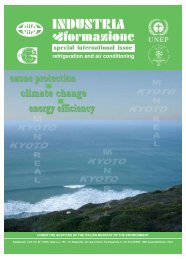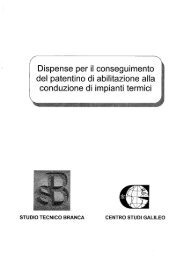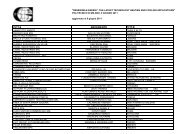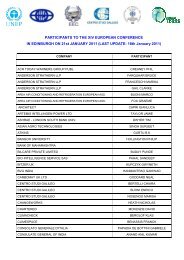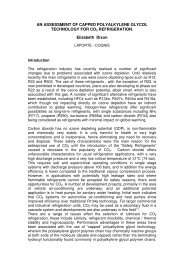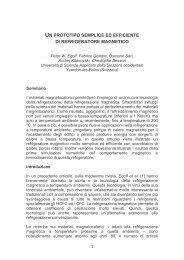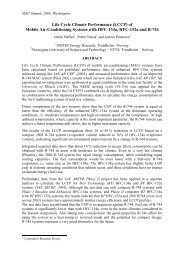PROPERTIES OF CO2 AS A REFRIGERANT - Centro Studi Galileo
PROPERTIES OF CO2 AS A REFRIGERANT - Centro Studi Galileo
PROPERTIES OF CO2 AS A REFRIGERANT - Centro Studi Galileo
You also want an ePaper? Increase the reach of your titles
YUMPU automatically turns print PDFs into web optimized ePapers that Google loves.
twentieth century, in particular in the Central and North European Countries. A German<br />
manual of 1915 lists 29 CO 2 compressor manufacturers in North Europe, 24 of them in<br />
Germany, a number hard to believe nowadays.<br />
The entrance into the market, starting from 1931, of the new synthesised halogenated<br />
refrigerants marked the rapid and inexorable decline in the use of carbon dioxide as a<br />
refrigerant, which though withstood in the field for long. In 1946, 88 percent of the British<br />
Fleet still used CO 2 as the refrigerant, and in 1963, 22 percent of the ships recorded in the<br />
French Register of Shipping was equipped with CO 2 refrigerating machines.<br />
The reasons for this rapid decline lay certainly in the low energy efficiency of this<br />
equipment, and in the drastic reduction in refrigerating power when ambient temperature<br />
increases (problem soon evidenced in ships crossing the warm equatorial seas). But certainly<br />
also in the failure of CO 2 compressor manufacturers to conform their production to modern<br />
technological developments (more compact and faster equipment, and therefore less costly).<br />
2. <strong>PROPERTIES</strong> <strong>OF</strong> CARBON DIOXIDE <strong>AS</strong> A <strong>REFRIGERANT</strong><br />
Quite a few general properties of CO 2 (official designation R-744 (<strong>AS</strong>HRAE 1997)) are<br />
absolutely ideal for the use of this product as a working fluid in vapour compression<br />
refrigerating machines and heat pumps (Lorentzen 1994):<br />
<br />
<br />
<br />
<br />
<br />
carbon dioxide is very abundant in the environment, waste of many technological<br />
processes; its cost is thus extremely low, easily available anywhere, and its recovery<br />
from dismissed equipment or in maintenance is not required;<br />
being a natural fluid, its harmlessness to the biosphere is demonstrated, both as far as<br />
known actions are concerned in the immediate (as the depletion of stratospheric<br />
ozone), and with reference to possible still unknown harmful actions (an always<br />
possible danger in the use of new synthesised products foreign to nature, as the<br />
happenings with CFCs and DDT have shown). CO 2 is certainly a greenhouse gas, but<br />
for its possible use as a refrigerant one recurs to recovery from industrial waste. For<br />
this application therefore the added greenhouse impact is to be considered nil, as nil is<br />
of course its impact on the stratospheric ozone depletion;<br />
it is a product that displays no special local safety problem, as it is non-flammable<br />
and non-toxic. Gas heavier than air, it can accumulate in the lower part of a nonventilated<br />
ambient, especially in a basement, causing suffocation for lack of oxygen.<br />
Holds of ships may be prone to this kind of events;<br />
it is an inert product, compatible with all common materials encountered in a<br />
refrigerating circuit, both metals and plastics or elastomers;<br />
special synthetic lubricants have been developed and are now tentatively available for<br />
CO 2 . They seem suitable and are under close scrutiny, with good results so far. The<br />
three most interesting candidates are at the moment POE, Alkyl Naftenic (AN) and<br />
PVE products.<br />
As far as thermodynamic properties of carbon dioxide are concerned, the state diagram p<br />
– h (pressure, in a logarithmic scale – specific enthalpy) is reproduced in Fig. 1. Table 1 gives<br />
values for some fundamental properties of carbon dioxide, together with those for R-22, and



